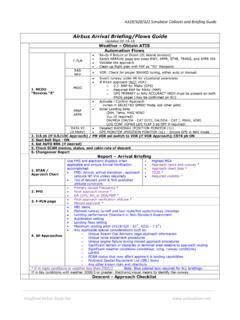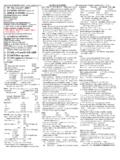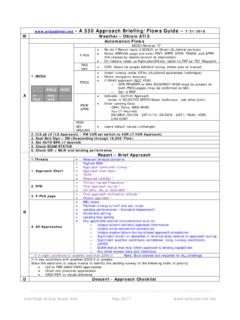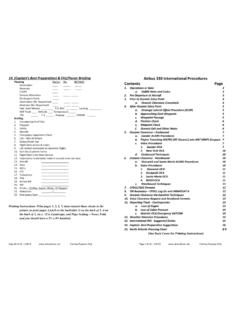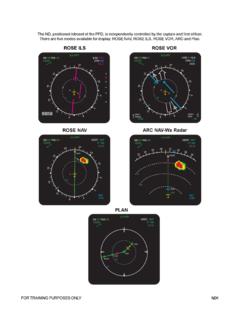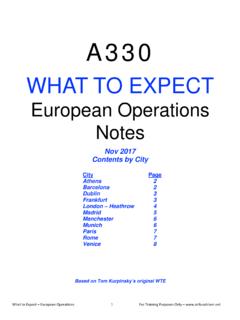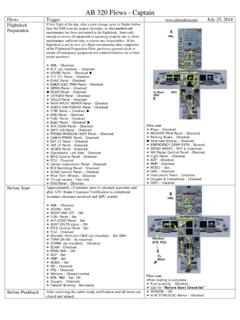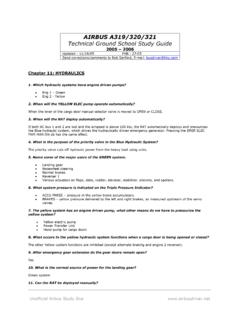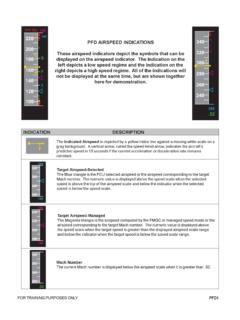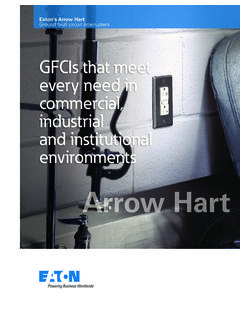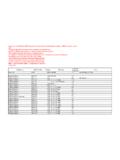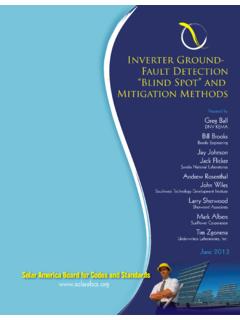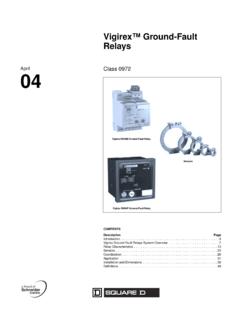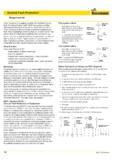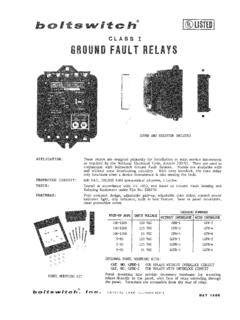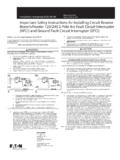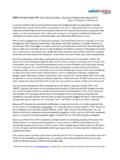Transcription of AIRBUS A319/320/321 Technical Ground School Study Guide
1 _____ Unofficial AIRBUS Study Site AIRBUS A319/320/321 Technical Ground School Study Guide 2006 2007 Updated : 10/09/06 PHB : 02-06 Send corrections / comments to Bob Sanford, E-mail: TGS PART ONE Chapter 6: Ice & Rain Protection 1. When should engine anti-ice be used? Ground and takeoff: Outside Air Temperature (OAT) is 10 C (50 F) or below and visible moisture in any form is present ( , clouds, fog with visibility of 1 mile or less, rain, snow, sleet, or ice crystals), or when operating on ramps, taxiways, or runways where surface snow, standing water, or slush may be ingested by the engines or freeze on engines, nacelles, or engine sensor probes. In flight: Total Air Temperature (TAT) is 10 C (50 F) or below and visible moisture in any form is present ( , clouds, fog with visibility of 1 mile or less, rain, snow, sleet, or ice crystals).
2 Engine anti-ice operation: Engine anti-ice must be ON during all Ground and flight operations when icing conditions exist or are anticipated (except during climb and cruise when the temperature is below -40 C SAT). Engine anti-ice must be ON prior to and during descent in icing conditions (including temps below -40 SAT). Caution: Do not rely on airframe visual icing cues to turn engine anti-ice ON. Use the temperature and visual moisture criteria specified below. Delaying the use of engine anti-ice until buildup is visible from the flight deck may result in severe engine damage and/or flameout. 2. After takeoff, when should WING ANTI-ICE be selected ON, if needed? Wing anti-ice operation: Select WING ANTI ICE ON after thrust reduction altitude Normally, WING ANTI ICE should be selected OFF at the FAF If in severe icing conditions, WING ANTI ICE may be left ON for landing Wing anti-ice is not permitted on the Ground or in flight when the TAT exceeds 10 C.
3 3. On approach, when should WING anti-ice be selected OFF? Wing anti-ice operation: Select WING ANTI-ICE ON after thrust reduction altitude Normally, WING ANTI ICE should be selected OFF at the FAF If in severe icing conditions, WING ANTI-ICE may be left ON for landing 4. When will probe heat automatically come on? On the Ground , low power is applied to the heaters when at least one engine is operating. In flight, the heating system automatically changes to high. The probe heaters can be activated manually prior to engine start by placing the PROBE/WINDOW HEAT pb ON. Note: The TAT probes are not heated on the Ground . _____ Unofficial AIRBUS Study Site 5. What happens to engine RPM when either engine anti-ice valve is open? The N1 limit for that engine is automatically reduced, and if necessary, the idle N1 is automatically increased for both engines in order to provide the required pressure.
4 Additionally, continuous ignition is activated for that engine. 6. What part of each wing is anti-iced with pneumatic bleed air? The three outboard slats on each wing. 7. What would happen if the RAIN RPLNT pushbutton was pushed on the Ground with the engines shut down? The RAIN RPLNT pb is inhibited on the Ground with the engines stopped. 8. Is electrical heat applied to the galley/lavatory drain masts anytime there is aircraft electrical power on the aircraft? The drain masts are heated any time the electrical system is powered. 9. What happens to the heat at the drain masts when the aircraft is on the Ground ? On the Ground , the heat is reduced to prevent injury to Ground personnel. 10. When are the windshields and side windows heated automatically on the Ground ?
5 The windshields and side windows are electrically heated for anti-icing and anti-fogging. The system is controlled automatically by the Window Heat Computers which provide regulation, protection, and fault indications. Windshield heat automatically operates at low power on the Ground with at least one engine operating. In flight, the windshield heating system changes to normal. The changeover is automatic. Only one heating level exists for the windows. The system can be activated manually prior to engine start by placing the PROBE/WINDOW HEAT pb ON. Chapter 10: Pneumatics 1. In flight, what happens if HP bleed air pressure is insufficient? Air is normally bled from the Intermediate Pressure stage of the high pressure compressor. When IP stage pressure and temperature are insufficient, a high pressure bleed valve opens to supply bleed air from the High Pressure stage.
6 In flight, if the pressure is insufficient even with the HP stage valve open, the engine speed is automatically increased to provide adequate air pressure. 2. The APU BLEED pb FAULT light illuminates amber when? This amber light illuminates and an ECAM caution appears when the system detects an APU bleed leak. 3. Can external air be used to supplement low APU bleed pressure? No 4. When does the crossbleed valve open with the X BLEED selector in AUTO? The crossbleed valve is open if the APU bleed valve is open. The crossbleed valve is closed if the APU bleed valve is closed, or in the case of a wing, pylon, or APU leak (except during engine start). 5. What controls and monitors the pneumatic system? Operation of the pneumatic system is controlled and monitored by two Bleed Monitoring Computers.
7 The BMCs provide indications and warnings to the ECAM and centralized fault display system. _____ Unofficial AIRBUS Study Site 6. Is it permissible to allow simultaneous introduction of external air with another source supplying the system? Do not use external conditioned air simultaneously with the airplane air conditioning packs. Chapter 10: Air Conditioning 1. What would an amber temperature indication in either the Pack Outlet Temperature or Pack Compressor Outlet Temperature indicate? The temperature changes from green to amber if the temperature exceeds the advisory threshold. 2. When would the LO selection on the PACK FLOW selector (A319/320) be used? PACK FLOW Selector (A319/320) LO: if number of pax is less than 50 or for long haul flights. HI: for abnormally hot and humid conditions.
8 NORM: for all other operating cases. ECON FLOW Selector (A321) ON: ECON FLOW if number of pax is less than 140. OFF: for normal flow 3. If bleed air is being supplied by the APU or if one pack fails, what will the pack flow rate be? During single pack operation or if the APU is supplying bleed air for air conditioning, pack controllers select high flow (A319/320) or normal flow (A321) automatically, regardless of selector position. 4. With the APU supplying bleed air what will be the pack flow if the PACK FLOW (A319/320) selector is LOW? A319/320 HIGH A321 - NORMAL 5. The pack flow control valve automatically closes for engine start when the mode selector is moved to IGN/START. When does the valve automatically reopen? Reopening of the valves is delayed for 30 seconds to avoid a supplementary pack closure during second engine start.
9 6. How is temperature in the flight deck and cabin controlled? The zone controller is a dual-channel computer which regulates the temperature of the flight deck and two cabin zones (FWD & AFT). It receives information from various temperature and flow sensors, compares these signals with the zone temperatures selected by the crew, and then directs the pack controllers to deliver air at the coolest demanded temperature to the mixing unit. Individual zone temperature is adjusted by mixing hot bleed air, through the trim air valves, into the zone distribution network. 7. Can the zone controller override the crew selected pack flow? The zone controller may override pilot selected pack flow, or it may increase APU speed or engine idle to meet temperature demands. I guess it just depends on its mood.
10 8. The ram air inlet flaps, for the ACM heat exchangers, automatically close under two conditions regardless of heat exchanger requirements. What are those two conditions? The ram air inlet flaps close temporarily at takeoff thrust application and at touchdown to prevent ingestion of debris. _____ Unofficial AIRBUS Study Site 9. When is the RAM AIR pushbutton used? During flight, if both packs fail, or in case of smoke in the cabin, a ram air inlet may be opened allowing ambient air to enter the mixing unit. 10. What ECAM page should be selected to verify aft cargo compartment temperature? COND 11. What Ground warning notice is given when a problem occurs with the ventilation system when the engines are stopped? The external horn sounds. 12. What indications on the ventilation panel are given if smoke is detected in the avionics ventilation duct?
